Garlic is one of the most popular spices in the world, used for centuries as a culinary delight and medicinal remedy. It has an intense aroma and flavor but offers more than just taste; it also boasts numerous health benefits. From fighting off colds to reducing inflammation, garlic has been used to treat various ailments throughout history. In this article, we’ll explore the various uses and benefits of garlic and how to incorporate it into your diet best.
What is Garlic?
Garlic is a member of the allium family, including onions and leeks. It is native to central Asia and has been used in cooking for thousands of years. Garlic is composed of multiple cloves, each with its papery skin. The whole clove can be eaten raw or cooked, depending on your preference. Garlic has a strong, pungent flavor that can be mellowed with cooking.
History and Origin of Garlic:
Garlic has been used for centuries in many cultures. It was first cultivated in Central Asia and is now widely grown worldwide. Ancient Egyptians used garlic to treat various ailments, from heart disease to infections. The ancient Greeks also praised its medicinal benefits, and it was widely used as a food preservative during the Middle Ages. Garlic has been used for centuries as a medicinal remedy and is still popular in many traditional medical practices today.
Types of Garlic:
Garlic comes in many forms, from fresh cloves to powders and pastes. The most common type of garlic is the Allium sativum, which can be white, pink, or purple. Other varieties include elephant garlic (Allium ampeloprasum) and black garlic (Allium tuberosum). Each variety has its distinct flavor and aroma, making them ideal for different dishes.
Nutrition of Garlic:
Garlic is an excellent source of manganese, vitamin B6, and vitamin C. It also contains selenium, calcium, copper, potassium, phosphorus, iron, and magnesium. The active ingredient in garlic is allicin, which has been studied for its health benefits. Allicin is released when garlic is chopped or crushed and cooked lightly to preserve the active ingredient.
Health Benefits of Garlic:
Garlic has been used medicinally for centuries thanks to its powerful antimicrobial properties. It can be used as a natural antibiotic to fight colds, infections, and certain cancers. It has also been used to reduce inflammation and improve heart health. Studies have shown that garlic can reduce cholesterol levels, lower blood pressure and decrease the risk of stroke. Additionally, it may help with digestion issues such as bloating and gas.
How to Plant Garlic Bulbs?
Garlic is a popular kitchen herb that has been used for both medicinal and culinary purposes for centuries. It’s also easy to grow with the right preparation and care. This article will discuss how to plant garlic bulbs, from choosing the best variety for your climate to preparing soil and planting in the correct season.
Choosing the Right Variety of Garlic Bulbs:
When it comes to choosing the right variety of garlic bulbs, many factors should be taken into consideration. Different climates will require different varieties of garlic, as some types may not be suitable for certain areas due to temperature or moisture levels. The soil type should also be considered; while most types will do well in moist but well-drained soil, some types may require a drier environment. Choosing high-quality, disease-free bulbs from a reputable source is also important.
Preparing the Soil:
Once you have chosen the right variety of garlic bulbs for your climate and area, it’s time to prepare the soil before planting. Garlic prefers fertile and well-drained soil that is rich in organic matter. To ensure proper nutrition, mix plenty of compost or other organic material into the top 6 inches of soil before planting. The pH level should be between 6 and 7; if necessary, adjust the pH levels with lime or sulfur accordingly. Finally, remove any rocks, weeds, or other debris that could impede root growth.
Planting Garlic Bulbs:
Garlic is best planted in the fall, anywhere from six to eight weeks before the ground freezes. Choose a sunny spot with at least 8 hours of direct sunlight daily. To plant your garlic bulbs, dig shallow holes 2-3 inches deep and 4-6 inches apart. Place a single clove into each hole, facing up and pointed end down, and cover with soil. Water thoroughly after planting to ensure successful germination and growth.
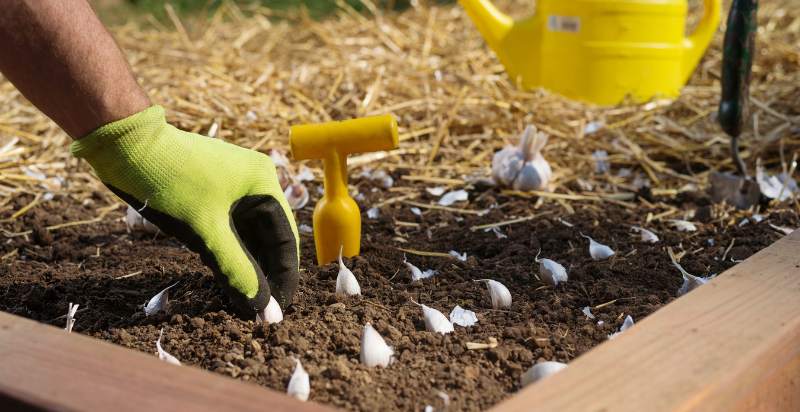
Caring for Garlic Plants:
Once planted, garlic plants require little care except for occasional weeding or mulching. Watering should be done regularly but not overly; too much water can lead to root rot or disease problems . Mulching the area around your plants will help keep moisture and weeds down. Finally, it’s important to harvest garlic bulbs properly; when the leaves begin to brown, pull up the entire plant and hang them upside-down to dry for one or two weeks. Once completely dried out, you can store garlic bulbs in a cool and dark place for several months.
Garlic is an easy-to-grow kitchen herb that is both nutritious and delicious. With the right preparation and care, it’s easy to produce a successful crop of garlic bulbs year after year. From choosing the right variety of garlic to preparing soil and planting correctly, following these steps should ensure healthy plants packed with flavor!
Following these steps, you should have a successful crop of garlic bulbs that you can use in your culinary and medicinal creations.
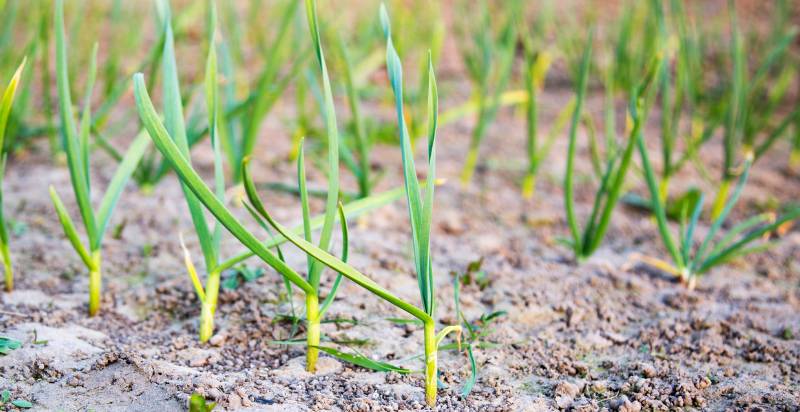
Preventions from Pests and Diseases:
Garlic is relatively resistant to pests and diseases, but it’s still important to take proactive measures to keep plants healthy. The best way to prevent problems with your garlic crop is by using preventive measures such as crop rotation, avoiding overcrowding, and removing any diseased plants from the area.
Additionally, you can use garlic-based sprays or natural pest repellents such as neem oil to help ward off unwelcome visitors. Finally, ensure that your plants get enough nutrients and water; this will help ensure healthy growth and reduce the chances of fungal infections or other diseases.

How to Harvest Garlic Bulbs?
Harvesting garlic bulbs is an exciting step in cultivating your garlic. Knowing when to harvest will help ensure the best flavor and biggest bulbs for eating. Garlic is ready to be harvested when the leaves on the top of the plant have turned brown and dried out.
To harvest, carefully dig around the bulb with a garden fork or shovel. Then, gently pull the plant from its root system and shake off any excess dirt. Separate each bulb from the stem, ensuring not to damage them in any way, as this could affect their storage time. The stems can then be composted or used as mulch in your garden beds.
Once you’ve harvested your garlic bulbs, you’ll need to cure them. This helps maintain their flavor and increase the storage time. To do this, hang the bulbs in a cool, dry place for about two weeks before you store them in a basket or other breathable container with plenty of airflows. Be sure to check on your garlic regularly during this time and discard any that have started to rot or become moldy.
Once they’ve been cured, your garlic is ready to be eaten! Enjoy it fresh from the garden, or store it for later use. Proper harvesting and curing techniques allow you to enjoy homegrown garlic all season long!
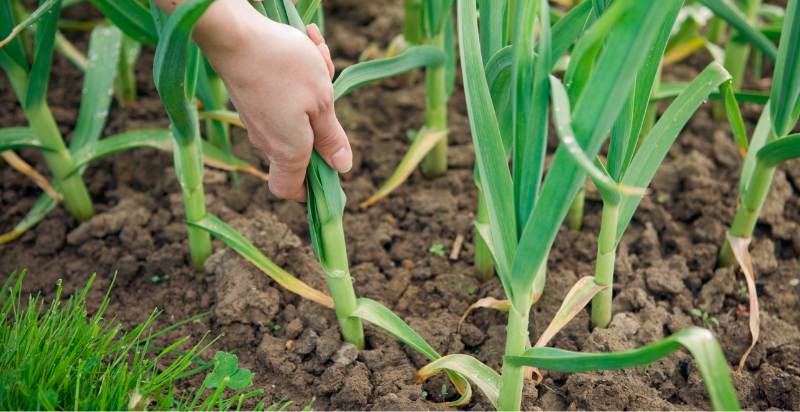
How to Store Homegrown Garlic Bulbs?
- Select firm heads of garlic with no visible disease or signs of decay. Avoid any that have already begun to sprout or show signs of mold.
- Break the bulbs into individual cloves, discarding any soft or damaged ones. Make sure not to damage the papery skin outside of each clove.
- Dry the garlic cloves in a warm, dry place for two to three weeks before storing them. This will help preserve their flavor and texture.
- Place each clove in a small breathable container with plenty of ventilation, like a mesh bag or cardboard box lined with newspaper or paper towels. These materials help regulate humidity levels and protect the garlic from moisture damage while allowing it to breathe.
- Store your garlic bulbs in a cool, dark place away from direct sunlight or heat sources, which can cause them to spoil more quickly. Refrigerators are also not ideal for storage as they tend to be too damp and may cause the bulb’s skin to become soft and spoil.
- Check your garlic bulbs regularly to make sure they are still in good condition, and discard any that become soft, moldy or start to sprout. Properly stored garlic can last up to six months or more under the right conditions. Enjoy your homegrown garlic!
Note: Make sure to consume the freshly harvested garlic within two weeks as it is prone to spoilage and does not store too well if left for long periods. Also, avoid keeping them near items like onions as these may encourage mold growth due to their strong odors, which could contaminate the garlic bulbs with dangerous bacteria. Lastly, never store wet garlic, as this will cause it to rot quickly, and it should be consumed immediately after harvesting instead.
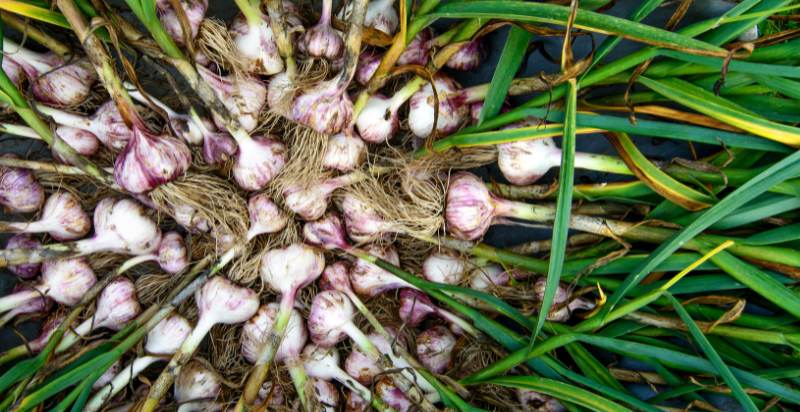
What are the Uses of Garlic?
Garlic has various uses in cooking, medicine, and even beauty treatments. The kitchen’s pungent flavor adds depth to various dishes, from soups to sauces. It is believed to have anti-inflammatory properties and can be used as an antiseptic for minor cuts and scrapes. Finally, garlic’s antibacterial and antifungal qualities make it excellent for treating skin problems such as acne or athlete’s foot. Garlic also contains many vitamins, minerals, and other important nutrients that may help improve overall health if consumed regularly in the diet.
As you can see, garlic is much more than just another herb! It is truly one of nature’s superfoods. So next time you want a tasty addition to your meals, consider adding some garlic! You won’t regret it.
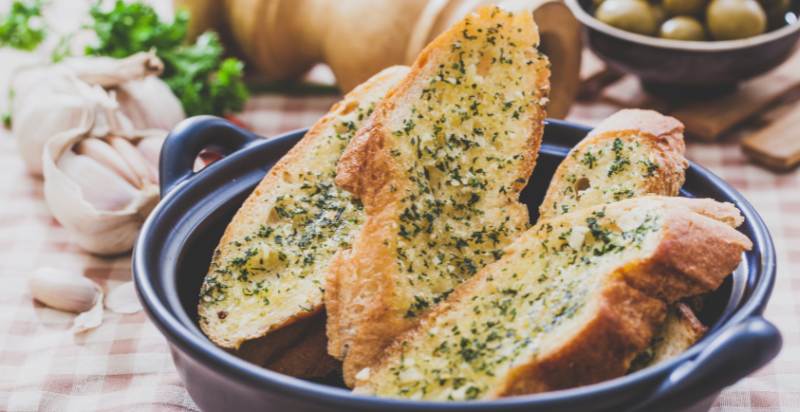
Conclusion:
Garlic is an incredibly versatile and flavourful herb with many culinary and medicinal uses. From soups to sauces and skin treatments to health benefits, it’s easy to see why this popular kitchen staple has been around for generations. Proper harvesting and storage techniques allow you to enjoy homegrown garlic any time of year. So give it a try today – you won’t be disappointed!
- Everything You Wanted to Know About Red Tamarillos - June 2, 2025
- A Guide to Tulips: Everything You Need to Know & More… - June 2, 2025
- Guanabana: Description, Flavor, Benefits, And Uses - May 27, 2025

66 thoughts on “How to Plant, Grow, and Harvest Garlic Bulbs ”
Comments are closed.